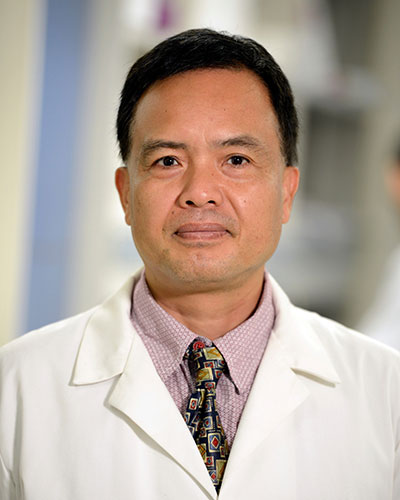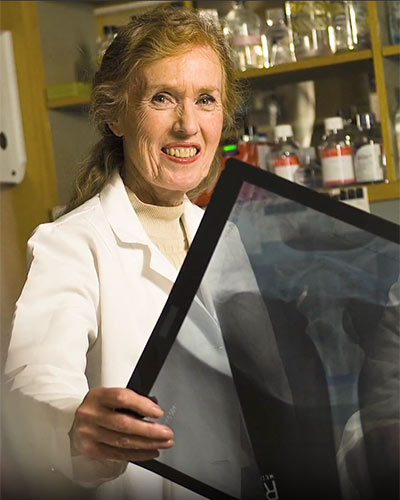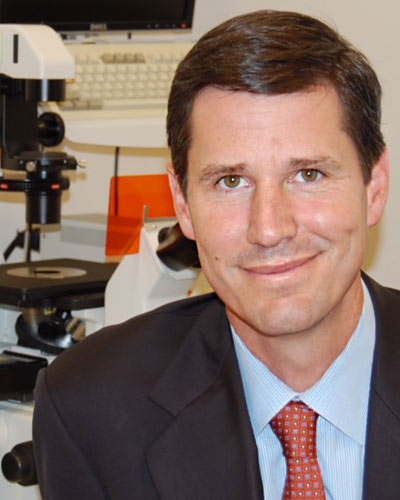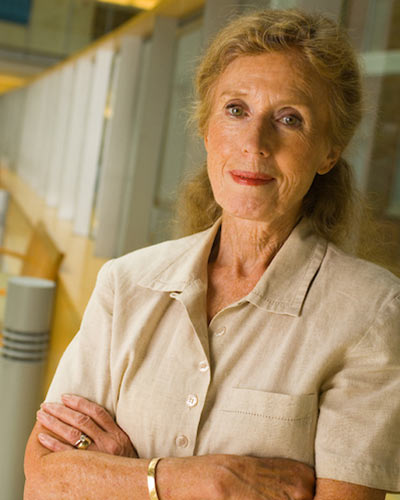August 07, 2017 | David Kohn

University of Maryland School of Medicine Researchers First to Discover Mechanism that Enables Breast Cancer to Become More Invasive
In 2017, more than 315,000 women in the U.S. are expected to be diagnosed with breast cancer. More than 40,000 are expected to die in 2017 from the disease. Over the course of their lives, one in 8 women in this country will develop invasive breast cancer.
One of the most common forms of the disease is ductal carcinoma in situ (DCIS), an early stage, non-invasive breast cancer. If untreated, these tumors become invasive, and are more difficult to treat. DCIS is thought to be the precursor of most invasive breast cancer. The molecular mechanisms underlying how DCIS becomes invasive have remained a mystery. For the first time, scientists at the University of Maryland School of Medicine have unraveled a key mechanism by which this form of breast cancer becomes invasive.
The discovery involves myoepithelial cells, which make up an outer layer of the breast, and help the organ pump milk. These cells play a crucial role in breast cancer. In the early stages of the disease, when it is not invasive yet, these cells act as tumor suppressors, and keep the disease from spreading. However, with aggressive strains of the disease, these cells transform, and are no longer able to subdue tumor spread. At this point, the cancer becomes invasive and begins to spread.
Until now, the process by which myoepithelial cells go from ally to enemy has remained a mystery to researchers. “This is very exciting,”said the lead researcher on the paper, Qun Zhou, MD, PhD, an associate professor in Biochemistry and Molecular Biology at UM SOM.“Until now we really had no idea what happened to myoepithelial cells on a molecular level that inhibited their cancer-fighting ability.” This discovery could point the way to new treatments that keep myoepithelial cells from being transformed.
The findings were published recently in the Journal of Biological Chemistry.
In the past, very few researchers had worked on myoepithelial cells, because they are extremely difficult to study. They are hard to isolate, and there are no animal models for them that resemble human cancer development. As a result, researchers must use human myoepithelial cells. Dr. Zhou and his colleagues spent the past several years figuring out how to isolate human myoepithelial cells, and then how to track them once they were isolated.
He and his colleagues took samples of myoepithelial cells from human breast cancer patients. Some of these cells came from patients who had early, noninvasive breast cancer, while other samples came from patients who had invasive breast cancer. They then co-cultured myoepithelial cells with DCIS breast cancer cells. The tumor cells that were combined with regular myoepithelial cells grew at a much lower rate than the tumor cells that were combined with the “tumor-associated” myoepithelial cells, which had been transformed.
Dr. Zhou found that the key component in this process is TGF-beta, a growth factor that plays a role many cancers, and has been found to increase the aggressiveness of DCIS. He identified a two-step process: first, TGF-beta causes tumors to increase production of a molecule known as miR-10b. In turn, MiR-10b inhibits a protein called RB1CC1, which suppresses tumors. So in essence, TGF-beta suppresses the tumor suppressor, and as a result the tumors grow more aggressively. This is the first time this mechanism has been identified.
Dr. Zhou says the next step for his lab is to screen compounds that prevent myoepithelial cells from losing their crucial ability to suppress tumors. He has already identified several likely candidates; eventually, he says, this work could lead to clinical breakthroughs.
“This study underscores the crucial importance of basic science, not only in cancer research, but in so many areas of science,”said Dean E. Albert Reece, MD, PhD, MBA, who is also the vice president for Medical Affairs, University of Maryland, and the John Z. and Akiko K. Bowers Distinguished Professor and Dean of the School of Medicine.“This work on the basic mechanisms of invasive breast cancer has the potential to lead to next-generation cures for hundreds of thousands of patients.”
About the University of Maryland School of Medicine
Commemorating its 210th Anniversary, the University of Maryland School of Medicine was chartered in 1807 as the first public medical school in the United States. It continues today as one of the fastest growing, top-tier biomedical research enterprises in the world -- with 43 academic departments, centers, institutes, and programs; and a faculty of more than 3,000 physicians, scientists, and allied health professionals, including members of the National Academy of Sciences, and a distinguished recipient of the Albert E. Lasker Award in Medical Research. With an operating budget of more than $1 billion, the School of Medicine works closely in partnership with the University of Maryland Medical Center and Medical System to provide research-intensive, academic and clinically-based care for more than 1.2 million patients each year. The School has over 2,500 students, residents, and fellows, and nearly $450 million in extramural funding, with more than half of its academic departments ranked in the top 20 among all public medical schools in the nation in research funding. As one of the seven professional schools that make up the University of Maryland, Baltimore campus, the School of Medicine has a total workforce of nearly 7,000 individuals. The combined School and Medical System (“University of Maryland Medicine”) has a total budget of $5 billion and an economic impact of nearly $15 billion on the state and local community. The School of Medicine faculty, which ranks as the 8th-highest public medical school in research productivity, is an innovator in translational medicine with 600 active patents and 24 start-up companies. The School works locally, nationally, and globally, with research and treatment facilities in 36 countries around the world. Visit medschool.umaryland.edu
Learn More
• Department of Biochemistry and Molecular Biology
• UM Marlene and Stewart Greenebaum Comprehensive Cancer Center
Contact
Office of Public Affairs
655 West Baltimore Street
Bressler Research Building 14-002
Baltimore, Maryland 21201-1559
Contact Media Relations
(410) 706-5260
Related stories

Tuesday, April 04, 2023
UM School of Medicine Study Finds ChatGPT Helpful for Breast Cancer Screening Advice, With Certain Caveats
As more consumers turn to the newly available ChatGPT for health advice, researchers are eager to see whether the information provided by the artificial intelligence chatbot is reliable and accurate. A new study conducted by researchers at the University of Maryland School of Medicine (UMSOM) indicates that the answers generated provide correct information the vast majority of the time; sometimes, though, the information is inaccurate or even fictitious.

Monday, October 29, 2018
UMSOM Honors Breast Cancer Awareness Month, Our Research Continues Toward Combating this Disease
October is Breast Cancer Awareness Month, and researchers at the University of Maryland School of Medicine (UMSOM) continue in their work to help combat this disease that impacts more than 315,000 women in the U.S. each year.

Thursday, June 07, 2018
Most Early-Stage Breast Cancer Patients with Intermediate Risk of Recurrence can Safely Avoid Chemotherapy
The majority of women with early-stage estrogen receptor (ER)-positive breast cancer, considered at intermediate risk of having their cancer recur based on a 21-gene test, can safely forgo treatment with chemotherapy, according to a large multicenter clinical study published in the New England Journal of Medicine.

Tuesday, August 15, 2017
Mother-Daughter Kayaking Team to Complete 300-Mile Trip in Baltimore to Honor Late UM SOM Scientist Dr. Angela Brodie
Patients who receive life-saving care from a physician or surgeon are often so grateful that they make generous gifts to medical schools and hospitals where they were treated.

Wednesday, June 07, 2017
In Memoriam: Angela Hartley Brodie, Ph.D., Internationally Renowned Breast Cancer Researcher at University of Maryland School of Medicine
Angela Hartley Brodie, PhD, Professor Emeritus in the Department of Pharmacology at the University of Maryland School of Medicine, and an internationally recognized scientist whose groundbreaking cancer research is considered among the greatest advances in treating breast cancer, passed away of complications from Parkinson’s disease at her home in Fulton, MD. She was 82.
